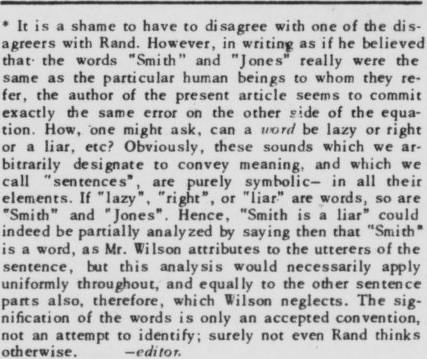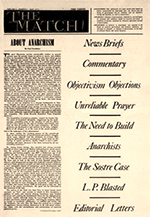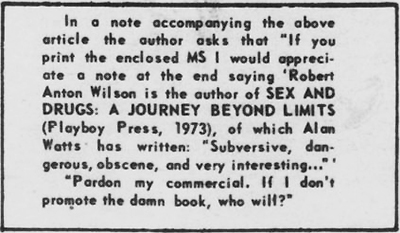Objections to Objectivism
Just how “rational” are the theories of Ayn Rand? One Anarchist provides us with a few answers …
Most Anarchists object to Objectivism on pragmatic or practical grounds: they feel that the Objectivist program of “limited government” has no feedback or fail-safe mechanism to prevent an evolution backward to the unlimited government which monotonously reappears whenever and wherever a State is instituted. Starting a government, in this view, is akin to starting a pregnancy, and Objectivism has no built-in abortifacient if the progeny prove monstrous.
Others, of course, object to Objectivism on more personal grounds, related to the mental evolution of Ayn Rand herself, who has become more and more indistinguishable from other apologists for the status quo. Her authoritarianism, dogmatism, intolerance, etc., have long suggested a basic incompatibility with real libertarian philosophy; this has become an acute contradiction recently, as she repudiated libertarian “limited government” candidates in the last election and endorded the “unlimited government” of Richard Nixon, whose invasions of noninvasive nations, sky-high taxes, government controls on virtually everything, wiretapping, etc. are as flat a contradiction of liberty as can be found west of Peking. Her weak attempts to justify these recent positions—saying, e.g. that she personally “trusts” Nixon and we should “trust” her “trust”—are the antithesis of libertarianism and a long step in the direction of the “miracle, mystery and authority” of traditional monarchy. If the government soon requires us to be tattooed with numbers on our arms, few would be surprised if Ayn Rand endorses this; and it seems likely that the die-hard Objectivists (those to whom even Nathaniel Branden is anathema since he split with the Grand Duchess) will probably follow her, and urge all of us to get our tattoos immediately. Objectivism seems destined to become one of the great authoritarian philosophies, in the tradition of Marxism, Thomism, Platonism, etc.
I share all these misgivings about Objectivism (as well as the very rational criticisms of Rand’s “antirational cult of reason” given in Dr. Albert Ellis‘ “Objectivism; Is It A Religion?”) but I think the central defect in the Rand scenario has seldom been stated by her critics. Objectivism, very simply, appears to be a map which does not fit any objective territory.
Human involvement in “nature” or “the universe” exists on at least three levels: the verbal, the objective, and the invisible. Objectivism identifies all three and can be described as no more reliable than a treatment of a cube which depicts it as a square or a line. Objectivism, as a map, distorts the structure or dimensionality of human experience, just as a philosophy of linearity distorts the dimensionality of a conic section.
Let us be country-simple about this. Despite Ms. Rand’s fondness for the “is” of identity, we happen to live in space-time continuum where a word NEVER IS the object which it denotes, just as, in the nice metaphor of mathematician Eric Temple Bell, the map is not the territory, or, in the even more memorable variation of philosopher Alan Watts, the menu is not the meal. We cannot drink the word “water”, eat the word “potato”, or live in the word “house”. Any system, such as Aristotle’s or Rand’s, based on saying that certain objective non-verbal events “are” certain words seems to be flirting with delusion or self-hypnosis. Smith “is” a liar, Jones “is” lazy, Johnson “is” always right, etc., either mean that Smith, Jones and Johnson ARE WORDS, which appears to be total nonsense, or mean something else than what they say. Ms. Rand, like Aristotle, writes constantly AS IF people, events, actions, actually ARE words, and this is what I mean by confusing cubes with squares or lines, identifying maps with territories, trying to eat the menu instead of the meal.*

It always comes as a distinct jolt, to people educated in traditional Aristotelian methods, when an actual encounter with the non-verbal, objective, sensual sensory level occurs. Such encounters can be triggered dozens of ways—e.g., Korzybski’s general semantics has its gimmicks for provoking this experience, yoga and Zen Buddhism and Gestalt Therapy have other methods. One of the easiest is mantra, staring at some interesting scene (such as the ocean) while holding the mind to one repeated verbalization, whether it be “I am here” or “om mani padme hum” or “the shadow knows” or whatnot; eventually the DIFFERENCE between these words (and any words) on one hand and the non-verbal world on the other, becomes strikingly clear.
This difference has never been clear to Ms. Rand, and, not surprisingly, Objectivism, as it evolved, has taken on the static quality of words and lost all contact with the dynamic quality of non-verbal experience. Howard Roark, in “The Fountainhead”, is glorified because he never changes (just like the word “mouse” never changes), while in the world known by experience, everything changes (just as the animal called “mouse” evolves from fetus to newborn to infant to child to adult, and dies.) Just as the verbal category “mammals” never changes, although Darwin found all actual mammals to be part of a chain of evolution, Ms. Rand’s “good” people remain “good”, her “bad” remain “bad”, and everything in her books seems to be preserved on a shelf like dead “specimens”, and not engaging in the life of the non-verbal, twinkling, sparkling, on-off, day-night, up-down, twist-turn, ALIVE world of sensory-sensual experience.
Verbalism, perhaps, would be a better name for the Rand system than Objectivism. Take any object, say a coffee cup, and start using it, playing with it, experimenting with it, and you will find (literally) infinite possibilities, which is the way life appears on the objective level. The Rand philosophy deals With the finite, static, absolute way life appears on the verbal level of the WORDS “coffee cup.”
This confusion of levels (between verbal and non-verbal) becomes intensified and more befuddling when the third (invisible) level is amalgamated with these two, as occurs in the Aristotelian and Rand systems.
Again, let us be country-simple here. The objects, events, experiences, of the non-verbal level appear, in the light of modern science, as creations of our nervous systems, just like the verbal level. That is, the space-time event which we call “an apple” exists evidently somewhere outside our skins, and, according to the most reliable (useful) equations, has a structure which can best be visualized or imagined as superimposition of waves of energy. The objective “apple” which we perceive does not contain this energy structure, which is known to us only by scientific and mathematical analysis and experiment; the “apple” of perception—the object—is manufactured by our senses and brain as they integrate various stimuli coming in from the energy-apple somewhere out there.
The invisible apple, the apple that we don’t see, the mathematical physicist’s or chemist’s “apple”, of course, contains the vitamins, flavor and other properties that make apples desirable to us. The visible apple, constructed by our nervous system, may not contain these needed elements—i.e., it may be a plastic or other artificial device designed to look like the invisible energy-apple that we really want.
Now, just as the objective apple (manufactured by our lower nervous system) is more dynamic than the word “apple” manufactured by higher levels of our nervous system), the external, invisible energy-apple appears still more dynamic. Every electron in it, for instance, is nonidentical with itself from second to second. (Every point has a date, in the Einstein-Minnkowski space-time manifold.)
Thus, we deal with “reality” on AT LEAST these three levels, now presented in summary:
(1) The verbal level of static, absolute unchanging, abstract WORDS, created by our higher nerve centers;
(2) The non-verbal “objective” level of more dynamic, only superficially static “things” or “actions”, abstracted by our lower nerve centers from external stimuli or clues;
(3) The non-verbal INVISIBLE energy-level of atomic, sub-atomic and complexly beknotted energy-clusters in a space-time manifold where nothing is static and structure is always infinite-valued.
This last point, the variable and multidimensional levels of structure within the invisible world, contains the real trouble-spot for Objectivism. “This is an apple,” “This is an energy-mesh,” “This is a genetic pattern in the ‘fruit’ family,” “This is an atomic structure,” “This is a molecular compound,” etc.—all literally untrue, since the event in question, whatever it is, is certainly NOT WORDS—can all be accepted as accurate descriptions, on different structural levels. But Ms. Rand’s one-valued system, in which the verbal, objective and invisible levels are all identified as one level, and treated as if that were the verbal level, carries the assumption that only one of these statements can be accurate, and that the others must all be false. This fatal defect in Aristotelian logic has made it unsuitable for modern science, just as the one-valued “time” of Newton and the one-valued “space” of Euclid have been found unsuitable.
It also appears unsuitable for the analysis of sociological facts. “Smith is a Republican,” “Smith is a member of the plumbers‘ union,” “Smith is anti-Negro,” “Smith is a Roman Catholic,” “Smith is kind to his children,” “Smith is a proletarian,” “Smith is red-headed,” again, appear as false-to-facts, since Smith is not a word, but can all be accepted as true descriptions on various levels; whereas in Aristotelian or Randian logic, one is encouraged to accept one of them as true and discard the others as irrelevant or, if the logic is being applied with real verbal fervor and total alienation from the sensory level, even as false. Again, the one-valued “is” tends to reduce multiple dimensions to two dimensions, and we get a “Flatland” view. (Literary critics disparage Rand’s novels, not because these critics “are” “all” liberals and socialists, as her admirers imagine, but because this flattening-out makes for awfully dull reading. Her description of these book s as “Romantic Realism” rings true only if one stresses the “Romantic” heavily and forgets the “Realism” entirely. The original two-dimensional novel, Abbot’s sci-fi classic, “Flatland”, is more convincing because his squares, triangles, circles, etc., are not presented as denizens of our sensory continuum. Band’s Roark, Dagny, Toohey, Mouch, and the others, fail to convince because they are not distanced this way and are set in our own space-time where. they don’t belong.)
Thus, Rand has a lot of fun “refuting” the paradoxes of modern physics and modern sociology, in “Atlas Shrugged” and other writings. These paradoxes, of course, only exist on the verbal level and are part of the two-valued structure of our Indo-European languages; one can discuss atomic physics in Hopi, for instance, without any paradoxes arising. (See Benjamin Lee Whorf’s “Language, Logic and Reality”.) Rand, however, identifying the verbal with the objective non-verbal and the objective non-verbal with the invisible-energetic non-verbal, imagines that the two-valued structure of these languages (and the Aristotelian logic derived from that grammar) MUST fit all levels—i.e., that the word “apple”, the objective apple, and the energetic-atomic apple are all identical, as implied in the Aristotelian sentence, “This is an apple.” To her, then, modern science appears a great hoax in which witch doctors are smuggling “mysticism” across the border disguised as mathematics.
Rand, it so happens, is mathematically illiterate. (This was true in 1962, when I met her in person. At that time, she could not read a partial differential equation, and apparently did not know what an exponent denotes. Her prose since then gives no evidence that she has become acquainted with mathematics in the interim.)
Thus, the structure of Indo-European language appears the only map-structure in which she can think, and any departure from it appears bizarre, witchy, “super-natural” to her. (Hence her abhorrence for mathematically-influenced modern painters like Kandinsky.) If the words for atomic processes grow weird (i.e. “waves” and “particles” are the same but not the same), then the processes must be weird; since processes cannot be self-contradictory in this way, the scientists must be lying to us.
Like Lenin in 1905, when the results of modern physics first began to diverge from Marxist dogma, Rand has deliberately turned her back on the non-verbal experimental and experiential world, which appears “unthinkable” to her, and embraces a purely verbal world, which, being her own creation, fits all of her hunches and notions of what “reality” should “really” be.
When a modern physicist is asked “Are electrons really particles or really waves?” he or she will probably answer, “Both”—at which point Rand begins muttering “witchdoctor” and harsher things. The physicist knows, as Rand doesn’t know, that the electron IS NOT WORDS, and hence IS NOT the word “waves” or the word “particles”. The physicist also knows that the mathematical equations which best describe the electron are also NOT the electron but just a description of it, written in a “language” (symbolism) where the Aristotelian either/or and its paradoxes do not arise.
Similarly with “Is Jones or Society responsible for Jones‘ children dying of starvation?” Sociologists, at least those worth elbow-room in a serious discussion, understand that the word “responsibility” has no referent on the non-verbal level, and realize that an answer depends on the level of structure (or degree of magnification) on which we examine the “facts”. To Rand, with a verbal system in which “Jones is responsible” ends the discussion, any attempt at further investigation on the non-verbal level, to discover the various structures actually functioning as the Jones children starve, appears pointless to her, if not more disguised “witchdoctory”.
Here we confront the gravest defect in the Aristotelian-Randian system, which Korzybski, in “Science and Sanity” calls “elementalism”. Through nobody’s fault, the universe in which we live appears non-linear, non-elementalistic, Gestaltish, synergetic. The space-time manifold cannot be broken up into “space” and “time” without re-introducing the Newtonian errors corrected by Michelson, Morley, Lorenz, Einstein, et al. The organism functions as-a-whole IN an environment, and re-introducing such Aristotelian entities as “ego”, “mind”, “emotions”, “senses”, reduces this multi-dimensional order to one-dimensional disorder, which is also false-to-facts. This does not mean that there is no rationality, or that we are all idiots (which is what Ms. Rand imagines is meant when anyone attempts to explain the Gestalt or synergetic approach to her) but that rationality occurs on various levels within the organism-environment manifold and cannot be elementalistically attributed to an isolated block-like entity, “mind” off in a hermetically-sealed sensory-deprivation chamber somewhere. All the structures function together, and no entity can be isolated and “explained” by contemplating it in fictitious isolation from all the structures. For instance, as Alex Bavelas has shown in some beautifully designed experiments, the “intelligence” of a group measures at different I.Q. levels depending on the communication-structure within the group.
(Wilson’s First Law, of which some of you may have heard, holds that communication is only possible between equals. It was based in part on the Bavelas experiments and in part on observations of communication-jams in Capitalist corporations and other authoritarian or pyramidal structures. Wilson’s Second Law, Progressive disorientation is experienced by all members of unequal groups, is the psychiatric justification for anarchism. Wilson’s Third Law, This disorientation continues until the SNAFU point and collapse, explains the inefficiency of armies and the decline-and-fall of States, corporations and other authoritarian structures.)
“Jones is responsible if his children starve” appears false, then, not just because “responsibility” is a word without a non-verbal referent, or because sentimentalists would like to feed the children before permanent brain damage or death supervene, but because “Jones” can be isolated from the space—time bio-social continuum ONLY ON THE VERBAL LEVEL. On the non-verbal levels, the invisible energy-mesh manifests as chains of cause-effect with structural unities apparent at atomic, chemical, nutritional, ecological, economic, sociological, and political levels, among others. Jones‘ stubbornness, orneriness, laziness, cussedness, etc., may appear on some of these levels; so may the cussedness of the local banker in contracting credit, or the decisions made by the Federal Reserve Board a thousand miles away, or the ecological havoc wrought by ill-informed or uncaring manufacturers one hundred years away, or nutritional misinformation acquired by Jones, Mrs. Jones, and the children from stupid authoritarian education, etc. etc.
I do not carry this analysis of starvation further, since Anarchists are familiar with it and can complete it for themselves. My point is that the web of sociological-ecological fallacy woven by Ms. Rand follows inevitably from her primary confusion of (1) the either/or elementalistic “logic” of the verbal level in Indo-European languages, with the (2) less static and less isolated world of neurologically-abstracted “objects” or “actions”, and (3) the totally dynamic, invisible world of actual energy-processes not detected by our nervous systems. In a three-level world, she pursues a one-level map and marches inevitably into escalating errors as the map again and again fails to correspond with the territory.
This article will have missed some of its intended effect if Anarchists just nod happily over it and say, “Well, Ayn Rand has been disposed of.” In my experience, Anarchists areas likely to confuse words with non-verbal multi-level synergetic realities as often as anyone else; Ms. Rand is relatively unique only in making this confusion a central part of her philosophy. In practice, such confusion needs to be checked by some counter force. Knowledge of several languages, including one or more of non-Indo-European structure, is helpful. Knowledge of mathematics is helpful. Training in general semantics, Gestalt therapy, or Zen meditation are helpful. LSD can be.
Best of all, perhaps, is a sense of humor and an awareness that the programming of one’s own biocomputer is not identical with the laws of the cosmos.

Objections to Objectivism
by Robert Anton Wilson appeared in The Match!, Volume 4, Number 5 in May 1973.


